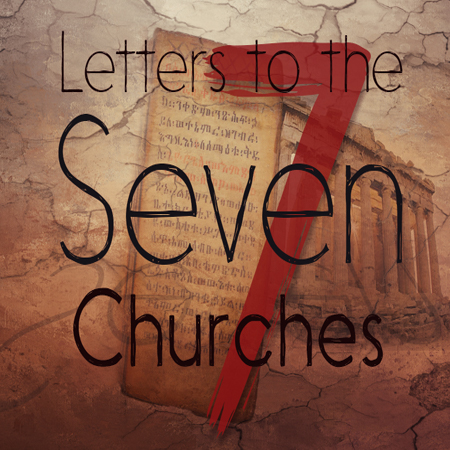9 I, John, your brother and partner in the tribulation and the kingdom and the patient endurance that are in Jesus, was on the island called Patmos on account of the word of God and the testimony of Jesus. 10 I was in the Spirit on the Lord’s day, and I heard behind me a loud voice like a trumpet 11 saying, “Write what you see in a book and send it to the seven churches, to Ephesus and to Smyrna and to Pergamum and to Thyatira and to Sardis and to Philadelphia and to Laodicea.”
12 Then I turned to see the voice that was speaking to me, and on turning I saw seven golden lampstands,13 and in the midst of the lampstands one like a son of man, clothed with a long robe and with a golden sash around his chest. 14 The hairs of his head were white, like white wool, like snow. His eyes were like a flame of fire, 15 his feet were like burnished bronze, refined in a furnace, and his voice was like the roar of many waters. 16 In his right hand he held seven stars, from his mouth came a sharp two-edged sword, and his face was like the sun shining in full strength.
Following the prologue and greeting, John conveys to the churches His vision of the risen Christ. He begins by describing himself as a fellow participant with them in the difficulties of following Christ. John accomplishes this by recognizing that being “in Jesus” involves the experience of both tribulation and kingdom reign. Christians share in Christ’s sufferings, but also in His benefits as His people. Ironically, we reign with Christ as we patiently endure hardships in this life while eagerly anticipating fully ruling with Him upon His return.
John’s description of his own circumstances highlights for the churches the tribulation which he was experiencing. He mentions being on the island of Patmos, a small island in the Icarian Sea where prisoners were often kept. According to church tradition he was exiled here because of his preaching and leadership in the church. It was on this island and on the Lord ’s Day that he received his vision which he describes as coming to him “in the spirit,” language which recalls the prophetic visions of Ezekiel (Ezek. 2:2, 3:12-14). He was then instructed to write down the things which he was going to see and to send them to the seven churches of Asia.
He then moves on to describe what he saw when he turned in response to the voice which had spoken to him. The first things he saw upon turning were seven golden lampstands. The number seven has already been mentioned twice within the book (1:4b, 1:11a) and so we are to take note of it here once again. These lampstands recall those which were within the holy place inside the temple. These lampstands were the only sources of light within this portion of the temple and therefore had to be tended by the priests who made sure that they were always burning. This imagery is carried over into the vision as John observes someone “in the midst” of the lampstands. He describes the one he sees as “like a son of man,” language which again recalls Daniel 7:13 and is intended to convey to the churches that the one he saw was the Messianic figure of that prophecy who is now understood to be the Lord Jesus.
Verses 13-16 then describe John’s vision of Christ which shows the churches His position and activity as their risen Savior. These descriptions convey Jesus’ role as the High Priest of the church (1:13) who possesses the wisdom of the Ancient of Days from Daniel 7 (1:14a) and who sees clearly and accurately so that He can properly judge the church (1:14b). He is the one who brings the very presence of God (1:15a) and who speaks with the authority of God (1:15b). He holds the churches and their leaders in His right hand (the place of power) and will defeat His enemies with the power of the Word of God that comes from His mouth (1:16). All of these attributes are summed up in the final description of His glory which is shown in His face shining like the sun in its brightness.
John’s presentation of the risen Christ is intended to evoke worship from the churches as well as to demonstrate that as the Priest and Ruler of the churches, He is in the position to judge them. Christians are drawn to worship Christ when they consider His attributes, but they must also remember that He loves His church and wants it to serve the purpose of bearing witness to the Word of God just as He did.
Join us this Sunday as we come together to fellowship around God’s Word and to consider in detail this amazing vision of our Risen Savior!
Soli Deo Gloria.
-Thomas

